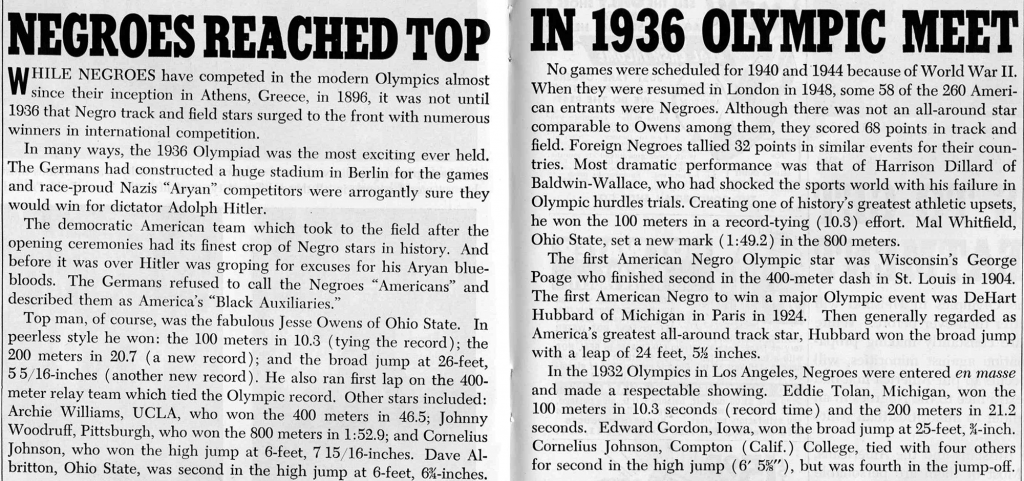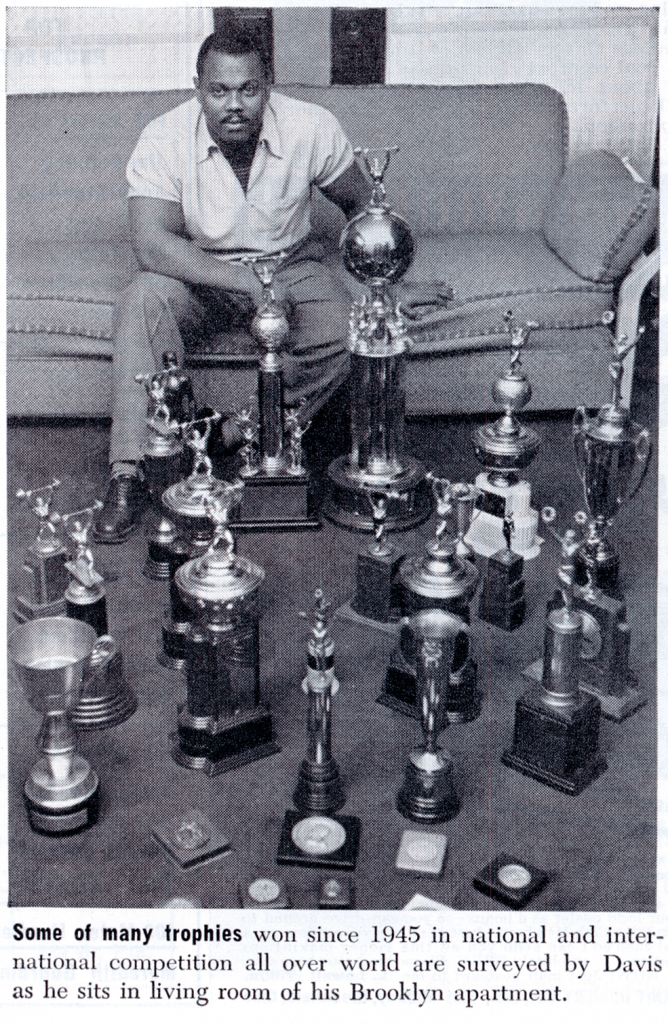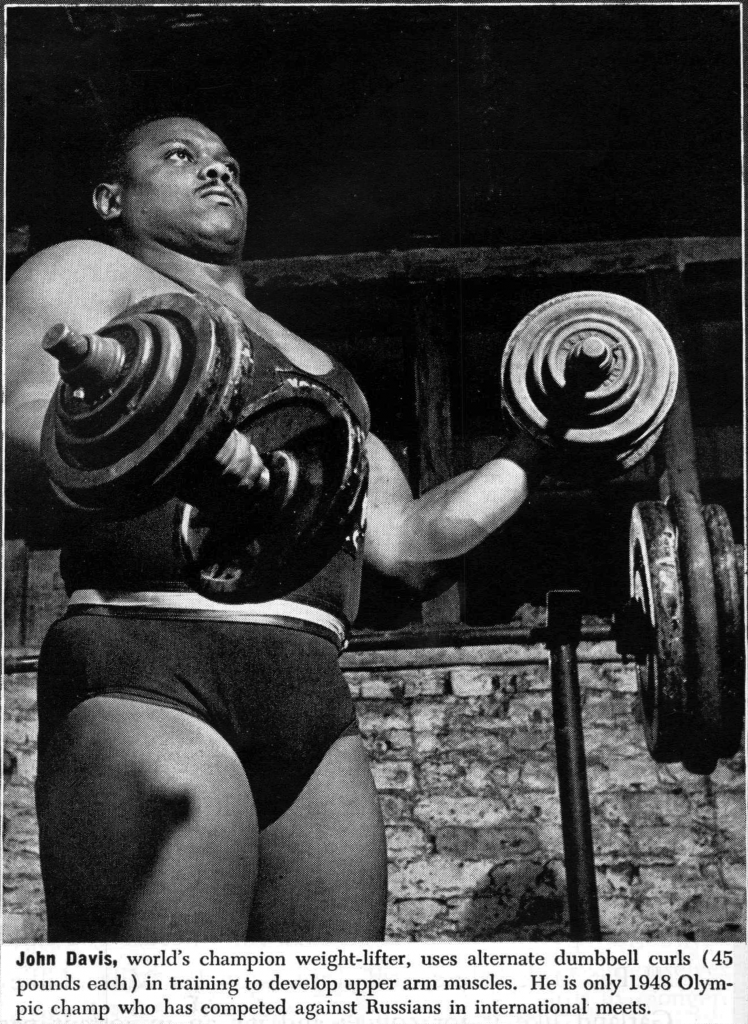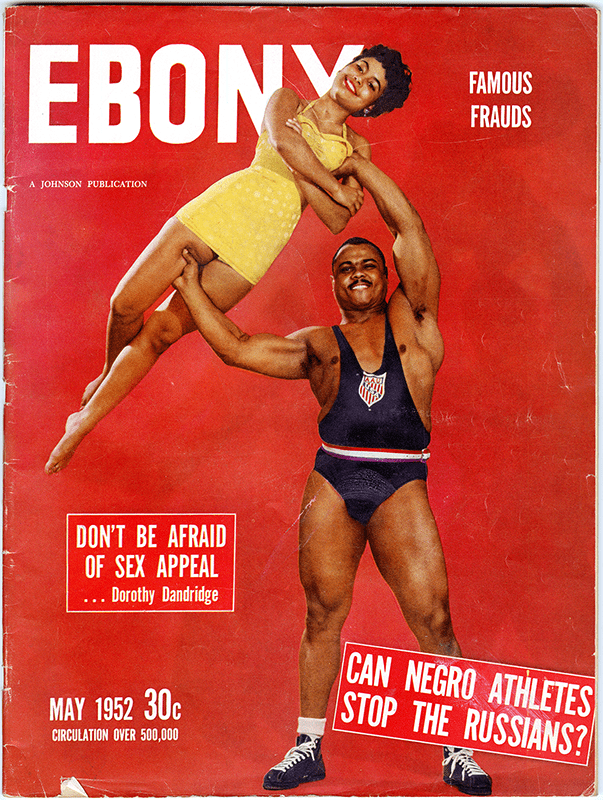In honor of Black History Month, I wanted to celebrate by sharing this issue of Ebony Magazine from May 1952. (Unfortunately, I’m late to publish this post due to Winter Storm Uri and the issues it created at The Stark Center. Please forgive my tardiness). In the lead up to the Olympic Games in Helsinki, Finland, Ebony published articles previewing the Games and the Black athletes who were set to compete. The 1952 Summer Games were highly anticipated because, for the first time in history, the Soviet Union would send its best athletes to the competition. The Cold War was spreading onto the field of play, prompting the question on the cover, “Can Negro Athletes Stop the Russians?”
This was neither the first time nor the last time that Black athletes were asked to represent the United States and defeat its political opponents on an international stage; no matter that at home, in their own country, they were living through segregation, discrimination, and many other legal forms of injustice. In 1952, the 1936 Berlin Olympics were still a fresh triumph in the American psyche. Jesse Owens and other Black athletes had won Olympic medals in Nazi Germany, disproving Adolf Hitler’s theories of Aryan superiority. The similarities between the Berlin Olympics and the Helsinki Olympics were not lost on Ebony Magazine who referenced Jesse Owens throughout their Olympic preview and included an article on the topic titled, “Negroes Reached Top in 1936 Olympic Meet.”

One of the challenges the editors at Ebony faced as they prepared their readers for a showdown between the US Olympic Team and the Soviet Team was the secrecy of the Iron Curtain. There was no scouting report on the Soviet athletes, which created a lot of uncertainty in how American athletes would match up with their counterparts – thus, the cover question, “Can Negro Athletes Stop the Russians?” When the editors at Ebony Magazine were deciding who to put on the cover of this issue, they must have wondered, who will be the Jesse Owens of these Olympics, who is the most sure bet to bring home the gold? Their answer was John Davis. In the cover photo, Davis’ beautiful, muscular body is on display as he holds Dorothy Brooks, a model, overhead and smiles with comfortable ease.
I spoke with Jason Shurley from the University of Wisconsin – Whitewater, who told me, “After [Davis] won the world championship in 1951, Bob Hoffman (Coach of the American Weightlifting Team from 1936 to 1968) said, ‘No athlete in any sport has dominated in his field more completely than Davis does.’” Presumably, this long run of dominance was exactly why Ebony Magazine chose to feature John Davis on the cover of their 1952 Olympic preview issue. Davis is also prominent inside the magazine; he appears in a number of photos, some that showcase his physique, others documenting his training regimen. He is the only athlete with an article dedicated solely to him. And when it actually came time to compete in Helsinki, John Davis did not disappoint.

Yakov Kutsenko was the Soviet Union’s best lifter in the heavyweight class and he even served as the flag bearer for the Soviet team when they made their entrance in Helsinki. But Davis had already beaten Kutsenko a number of times. The first instance was at the 1946 World Weightlifting Championships in Paris; after which, the Soviet Union withdrew from world weightlifting competition until 1950. “When they returned,” Dr. Shurley explained, “Kutsenko…had reportedly hit 1019 in training, which would have been 10lbs more than Davis’ best. At the 1950 championships, Davis totaled 1019 with his first clean and jerk (the total Kutsenko was supposedly going to hit) and then passed on his two remaining attempts. Kutsenko only managed 931 and the Soviets skipped the world championships the following year (1951).” Ultimately, the Soviet Union decided to withhold Kutsenko and anyone else from competing against John Davis at the 1952 Games. “Davis was the world’s strongest man and the Russians knew it,” says Dr. Shurley. Davis won the gold medal and set Olympic records in the press, snatch, and total. His victory gave the US Weightlifting team a fourth gold medal, one more than the Soviet team.
I especially find John Davis to be a captivating figure because he was not just a phenomenal weightlifter, he was an extraordinary athlete all-around. In 1952, John Davis, having dominated the sport of weightlifting for a decade, really seemed like he might be Superman. In the lead up to the Olympic Games in Helsinki, Davis was also the subject of a short documentary. According to Dr. Shurley, the documentary film was “purchased by the US military and shown to American military personnel throughout the world as a way to counteract Soviet propaganda about the racism in the US.” Unfortunately, John Davis never received the attention he deserved. “Despite his amazing success as a lifter and utility as a symbol that the US was an egalitarian society,” explains Dr. Shurley, “he was never widely recognized in American society; in a 1952 poll of “sports experts” 7 out of 10 failed to identify him. Davis himself once commented that, outside of weightlifting ‘I don’t think fifteen people ever heard of me.’”

While this issue of Ebony Magazine gives us some wonderful photographs and insights to the experience of John Davis and other Black athletes as they prepared for the 1952 Olympic Games, it’s worth noting that there are no prominent photographs or articles dedicated to female athletes. Towards the end of its cover story, Ebony Magazine notes, “While several foreign countries will field full teams of women, America generally will be handicapped in competition with them because of lack of facilities for training, lack of experienced coaches, and apathy of colleges toward women’s track and field competition.” It’s sad to say, but how true.
This specific issue of Ebony Magazine came to The Stark Center as part of Ottley Coulter’s collection. Coulter collected single issues of mainstream magazines if their covers featured weightlifters when he saw them on newsstands. I want to give a special thanks to Jason Shurley for agreeing to be interviewed for this blog post. For more information on John Davis, I highly recommend Jason’s essay “Unequaled Yet Never Equal: The Portrayal of John Davis in Strength & Health Magazine, 1938-1957” which appeared in Iron Game History Volume 13 Number 4. Here is a link to that essay.




Leave a Reply